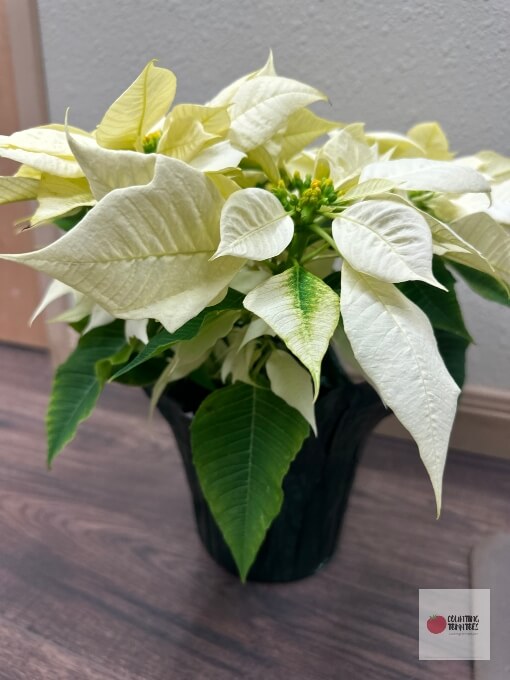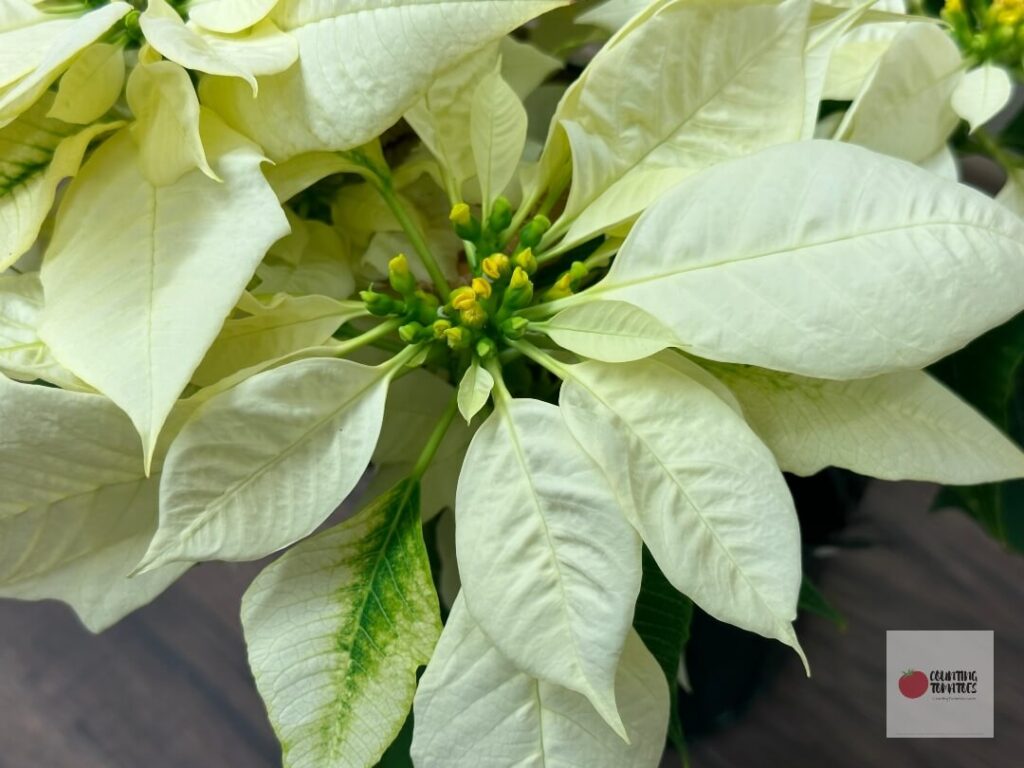The poinsettia plant, euphorbia pulcherrima, is a perennial shrub native to Mexico. Poinsettias are tropical plants that thrive year around in the lush rain forests where temperatures remain above 50 degrees. In 1825 Joel Robert Poinsett, the first U.S. ambassador to Mexico, brought back these vibrant red blooming plants to the United States from southern Mexico. Poinsettias have made their way into our holiday décor here in America since that date. The native plants are typically red, however, botanists have hybridized the plant so now we have a range of colors such as burgundy, pink and white.
The flowers of the poinsettia are actually clusters of tiny yellow berry-like structures surrounded by the colorful bracts. The bracts which are often, red, pink, or white, are modified leaves.

How to Select a Healthy Poinsettia Plant
Choose a plant that looks full with vibrant, brightly colored bracts. Avoid choosing a plant with curling leaves or bracts or with wilted or broken stems. The plant should feel heavy indicating the poinsettia is not stressed by a lack of water.

Your plant may be wrapped in clear plastic film to protect it while in transit from the nursery to the store. Once home, remove the clear plastic wrap promptly.
How Often Should You Water a Poinsettia
- Water poinsettias when the surface of the soil feels dry to the touch.
- Water the top of the soil using a watering can or water spigot.
- Allow the water to soak through the soil and drain. Water again in a few minutes if the water rapidly flowed through the soil substrate.
- When watering, avoid blocking the drainage hole in the bottom of the pot.
- Most poinsettias sold during the winter holidays are wrapped in a foil wrapper for presentation. Remove any foil wrapping from the pot when watering the poinsettia to allow the excess water to drain.

Can you Over Water a Poinsettia?
Over watering is one of the more detrimental things you can do to these festive plants and it can lead to root rot. Allow the excess water to drain when watering will prevent the plant from sitting in water.
Signs of too much water include:
- Leaves turning from red or green to yellow
- Premature loss of leaves
Can you Under Water a Poinsettia?
Yes, it’s easy to forget to care for your poinsettia during the hustle and bustle of the Christmas season.
Signs of too little water include:
- Leaves curling and falling off of the plant
- The leaves wilt
If you notice the plant is wilting, promptly give it a good watering with room temperature water. The plant will recover.
Once the plant is rehydrated and perky, water again when the top of the soil feels dry. You may notice some of the leaves still drop even after the plant is rehydrated. This is normal when recovering from wilt. The poinsettia will sprout new growth and bounce back to a healthy plant with proper care.
How to Care for Poinsettia Plants after Christmas
Did you know that a poinsettia is actual a perennial plant and can live and thrive beyond the holidays? Following these simple tips for proper care will enable you to enjoy a poinsettia’s green foliage throughout the year. Toward the holidays, you can force the poinsettia to turn it’s bracts into colorful foliage just in time for another holiday season!

After the holidays, the poinsettia will maintain it’s colorful bracts through January and possibly into February. Follow the watering tips above to keep the plant thriving.
Eventually, the plant will begin to drop it’s leaves to prepare for dormancy. This is the time when you will prune the poinsettia.
Using a clean, sharp pair of pruners or scissors, cut the stems of the poinsettia until they are approximately 3″ – 4″ above the soil. Keep the plant indoors in a well-lit room where it can it can get plenty of indirect light. The poinsettia will begin to sprout new leaves.
Once new growth emerges, water the plant weekly with a liquid soluble general all-purpose balanced fertilizer.
Poinsettia Care Tips in the Spring and Summer
Your poinsettia plant can be moved outdoors once the nighttime temperature is above 50°F. Place the poinsettia in a sunny spot; want to offer afternoon shade to keep it from drying out too much. Due to the hotter temperatures poinsettias will need more water than during the holidays. Provide enough water to keep the plant hydrated, but do not allow the soil to become overly saturated.
In May or June, you’ll want to pinch back your poinsettia plant to encourage bushier growth. This is a similar process to pinching back mums you have overwintered. Pinch the stems back until they are 5″ – 6″ long. Continue fertilizing monthly.
In August or September, you may choose to do one final pruning to encourage more branching and bushier growth. You will stop fertilizing after the final pruning to start the process of forcing the poinsettia to “bloom.”
Care of a Poinsettia Care in the Fall
Bring the poinsettia indoors when the nighttime temperature drops below 50°F. Be sure the plant is in a well-lit room with plenty of indirect light. Start to pull back watering, allowing the soil to be dry to the touch between watering. Refrain from using any fertilizer.
Much like another popular holiday plant, the Christmas cactus, you will need to force the poinsettia to “bloom.” Forced blooming is achieved by creating enough hours of darkness to force the poinsettia leaves to turn vibrant colors in time for the holidays.
How to Force Poinsettia “Blooms”
Approximately 6 weeks are needed of adequate dark hours to force the beautiful leaf color to appear. If you wish to have blooms in time for Christmas, start the process around the first of November. If you’d like your poinsettia to bloom around Thanksgiving, start the process around the second week of October.
Each evening, place the poinsettia in a dark closet or cover the pot with a cardboard box so the plant spends 14 hours everyday in total darkness. The closet should not have any additional sources of light. Each morning, place the poinsettia again in a well-lit room with plenty of indirect light. Continue to water as usual.

After 6 weeks of this process you will notice the colorful leaves have returned just in time for the holidays!
A Few Final Thoughts on Poinsettia Care
Expect to enjoy the full bloom of the poinsettia from anywhere from 4 to 8 weeks with proper care. After several holiday seasons, you may notice the poinsettia has outgrown its poinsettia pot. Repotting a poinsettia should be done in mid-summer before it begins the process to force the leaf color change.
A poinsettia could become a life long Christmas heirloom in your family. A Canadian man has kept this poinsettia for 26 years and it is still bringing him joy!
Linking up with The Cape Coop



Yep, I needed a couple of reminders to care for my poinsettias this year. I usually don’t worry about it much since my husband manages a greenhouse and looks after the plants, but sometimes I do need to take responsibility for watering! 😉
Your husband sounds like he has a dream job!! Thanks for stopping by and happy gardening!!
Stacie, I really appreciate you sharing this information. I was wondering why I have no luck when keeping poinsettias. I’ve since given up buying them. But I’m bookmarking this because I want to try again.
Thank you bunches for sharing this with Sweet Tea & Friends this month.
Paula,
You are very welcome! I hope these tips help you to keep your poinsettias year after year. Thanks for stopping by; happy gardening!
Stacie
Great post on how to care for this lovely Christmas flower/plant! Love how you answered questions on your headings! I’m here from Simply Coffee and Jesus. We’d love for you to link up at Tuesday Turn About! Hope to see you there!
Thank you so much Julie! I love to be able to quickly find what I need from a post, so I’m glad you found my headings helpful as well. Looking forward to Tuesday Turn About; thanks for sharing that with me! – Stacie